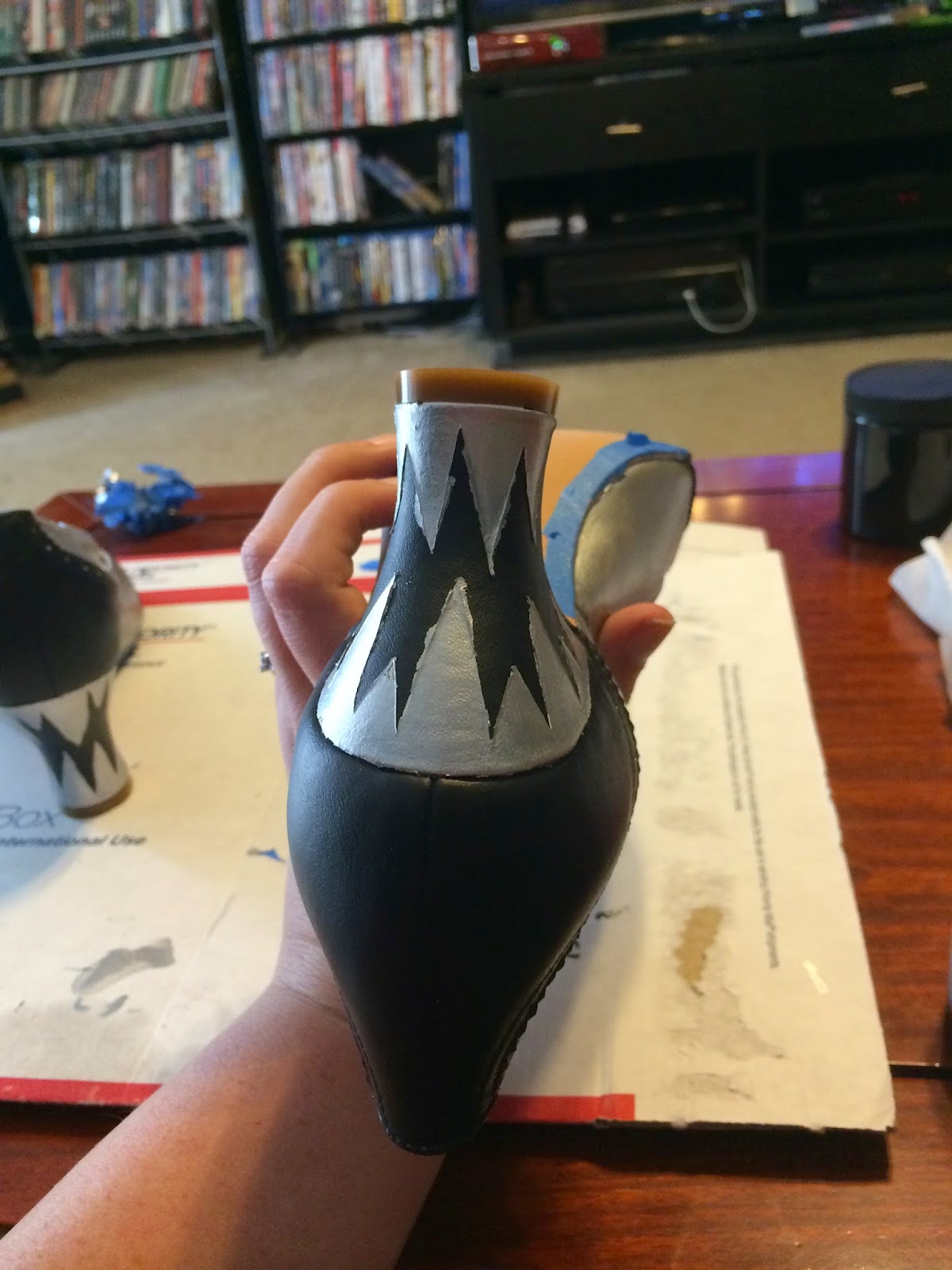For Costume College this year I knew I needed to have fabulous shoes to go with my Gala dress. I couldn't put all that work into beading the dress and have boring shoes. So after some research, I drew my inspiration from this image.
 |
| Jeweled heels ca. 1925 via The Kyoto Costume Institute |
I also used these tutorials as a guide: How to paint your own 1920s flapper shoes.
I started with the "23 Skidoo" Spectator T-Strap Shoes (White) as my base.
I chose these shoes because they were white and the right shape. When you're searching for shoes to use in this tutorial, I recommend finding one with the right shape since the color can be altered. The first thing I did was tape off the inside of my shoes. Even though people will never see the insides, when they are being worn, I didn't want to muck up the dark red interior. If you aren't afraid of possible drips or smears you can skip this step.
Before painting you have to take off any finishes the shoe already has. I used Angelus Leather Preparer and Deglazer for this. You can get it at several places online. I ordered mine from American Duchess to save on shipping, since I was getting my shoes from there already.
The deglazer reminded me of paint thinner so I was careful not to rub to much. I made sure I went over every area 2-3 times to take the shine/finish off, but noticed if I passed over any one area to much it got a tacky feeling to it. I let that dry overnight before I taped off the areas that would be painted black. You need to be extra careful with tucking the tape under the over lapping toe and heel portions. Having to go back into the crevices with the silver to cover black paint that had dripped is a nightmare. Luckily I only had to go back in a couple spots.
If you are extremely careful you could probably skip this step. As you can see in the next picture I'm not that careful. I chose to paint my shoes with Jacquard Lumiere Acrylic paints. I've had really good results with them on fabric and seen good reviews for their use on shoes.
The black portions took two coats with a few minor touch ups wherever there were white specs. I allowed the paint to dry thoroughly before I removed the tape.
I didn't tape off any boarders for the silver portions. Touching up the smudged black portions wasn't as difficult as covering black paint with silver.
To transfer the heel pattern to the shoes I began by wrapping a piece of scrap fabric around the heel and tracing around the edges. This allowed me to have a flat pattern from a 3D shape.


I drew the pattern I wanted to use on the fabric and then transferred that design to painter's tape via carbon paper.
Next I took an exacto knife and cut along the lines of the design. My base was already black and the spikes were going to be silver so I took the inverse of the design.
To fix the ridges left behind from the layers of paint, I used an extra fine sand paper. You want to use an extremely light hand while using the sandpaper. If you are heavy handed you will take off to much paint and possibly mess up the leather layers below. Once the layers were smooth I touched up all the lines.
To transfer the heel pattern to the shoes I began by wrapping a piece of scrap fabric around the heel and tracing around the edges. This allowed me to have a flat pattern from a 3D shape.


I drew the pattern I wanted to use on the fabric and then transferred that design to painter's tape via carbon paper.
Next I took an exacto knife and cut along the lines of the design. My base was already black and the spikes were going to be silver so I took the inverse of the design.
It was about here when I was putting the tape outline on the shoe that I realized a flaw in my plan. The fabric has some stretch along the bias whereas the tape doesn't. I had to fudge with the pattern a bit, by slashing and spreading it, to make it fit properly.
The silver paint required more coats to cover everything properly than black paint did. If I was to do a project like this again I would airbrush each layer so they're not as thick. This was especially apparent when I peeled the tape away.
 |
| ewwwwww |
 |
| MUCH BETTER!!!!!!! |
Once I could convince myself I didn't need to do anymore touch ups I allowed it to dry overnight to make sure the paint was completely dry. I then applied Angelus Acrylic Finisher (Matte) over all of the painted areas.
I used 4 different sizes of Rhinestone on the heels. I attached the Rhinestone to the heels with a Swarovski crystal glue pen. It's meant to attach the crystals to Jewelry components but worked really well with this project. It also has an extremely helpful tip that makes grabbing and placing the smaller rhinestones much easier.
I found it was easier to stage the Rhinestones on my template vs. doing them one at a time. I also found it useful to put the Rhinestones on from both ends meeting in the middle. This helped with keeping the spacing between each row even.
Once you get to this stage it seems to take FOREVER, but I think a lot of that is because you are so close.
Stick with it. It's worth it I promise.
* If you do end up using this tutorial, leave a link in the comments. I would love to see what you come up with!


















.jpg)

.jpg)



.JPG)